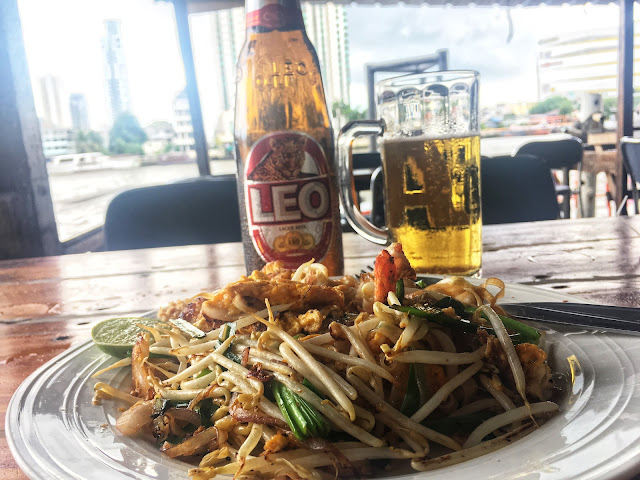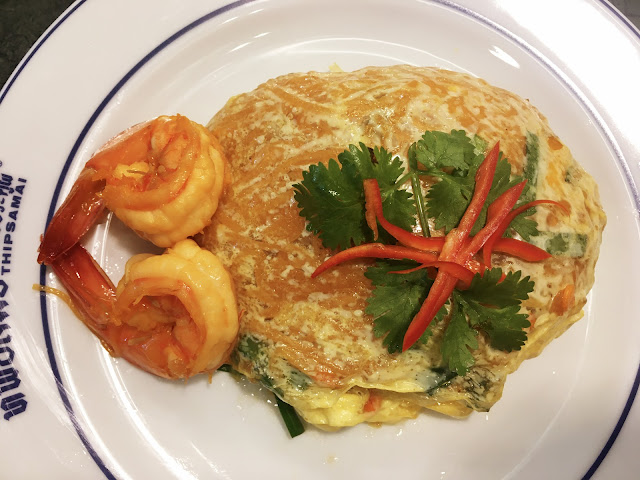The Secret History of Pad Thai (ผัดไทย)
Thailand's National Dish
 |
| a plate of Pad Thai (ผัดไทย) |
 |
| Field Marshal Plaek Phibunsongkhram |
Field Marshal Plaek, known by his nickname "Pibun", is a complicated figure in Thai history. He was part of the 1933 coup which ended the absolute monarchy in Siam, after which he declared himself Prime Minister and served for a record 15 years.
- Thailand's first constitution and the end of the absolute monarchy
- The beginning of Thai democracy and the country's first constitution
- The absorption of the Kingdom of Chiang Mai (a quasi-independent client state to Siam) and the unification of Siam
- The change of name from Siam to Thailand (an effort to modernize the country)
- The introduction of the greeting "Sawatdee" (in an attempt to create an analogue to "hello"; the previous Thai greeting was "have you eaten yet?")
- The creation of the modern Thai tri-color flag modeled after those in the West
- The creation of the Thai National Anthem
- A series of Cultural Mandates, most of which are still in effect today
A Few Favorite Pad Thai Spots in Bangkok
Jack's Bar
Jack's Bar doesn't serve the best pad Thai in Bangkok, nor does it claim to, however it's a dish that is designed perfectly for a farang's (foreigner's) palate! Anyway, Jack's Bar isn't so much about the dish itself (though it's an absolutely solid serving of pad Thai) as it is about the atmosphere. Built in a rickety hut atop an even more rickety pier overlooking the Chaophraya River, Jack's is a Bangkok institution. It's the cheapest riverside restaurant in the city, with giant bottles of cheap Leo beer (served over ice in the Thai style, of course), and huge servings of Thai street food classics.
Jack's Bar isn't just a cool location to enjoy a plate of pad Thai, though. It actually has really good reviews by Thai chefs and food critics alike. Don't let the basic amenities fool you. Jack's may be a relatively cheap and basic place to grab a beer and a bite to eat, but it's got some excellent food.
 |
| a plate of pad Thai and a Leo beer at Jack's Bar in Bangkok, Thailand |
Pad Thai Mr. Hui
Mr. Hui still makes Pad Thai in a traditional way, and adds several elements that make his dish so special. He has created a very old-fashioned dish using elements of his own Chinese-Thai heritage, and has chosen a few special ingredients to give his pad Thai its signature flavor:
- He cooks his dishes in pork fat instead of vegetable oil.
- He cooks everything in a big wok over charcoal instead of the more common gas stove.
- He uses duck eggs instead of regular chicken eggs, which gives the dish a richer and fattier taste.
 |
| Mr. Hui's Pad Thai |
Thipsamai
https://www.theworldofstreetfood.com/2020/08/the-original-pad-thai-at-thipsamai.html
Like any good pad Thai, the dishes served up at Thipsamai, Bangkok's historic and most famous original Pad Thai restaurant, are stir-fried in a smoky wok with lots of oil. Thin rice noodles (not the thick, flat noodles you'll see in more Western-style pad Thai dishes) are soaked in aromatics and lots of sweet and savory sauce, and the whole dish is tossed with big, fat shrimp. The pad Thai at Thipsamai can be ordered "wrapped in egg", a very traditional way to serve it that you won't see much outside of Thailand. I highly recommend ordering the dish this way! The noodles are wrapped in a paper-thin omelet, which adds some body and extra flavor to the dish.
 |
| famous Thipsamai Pad Thai |
Comments
Post a Comment